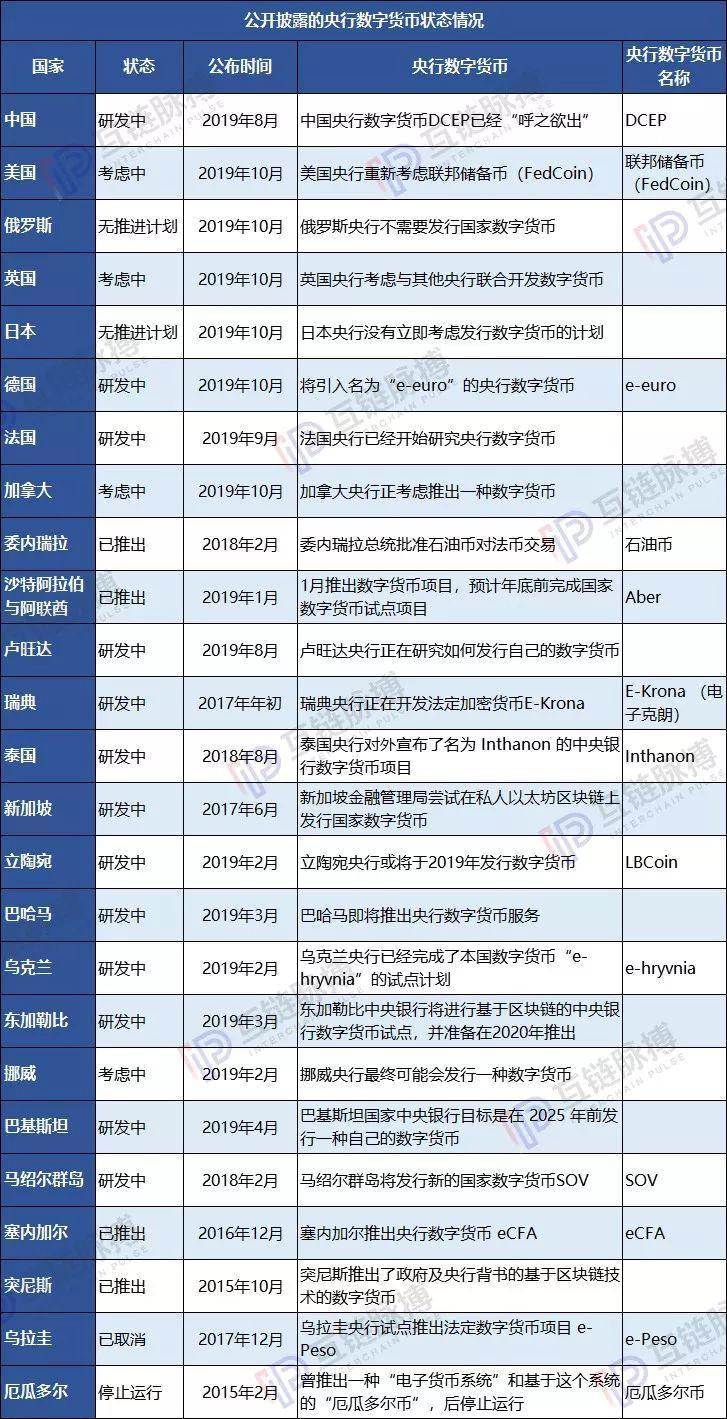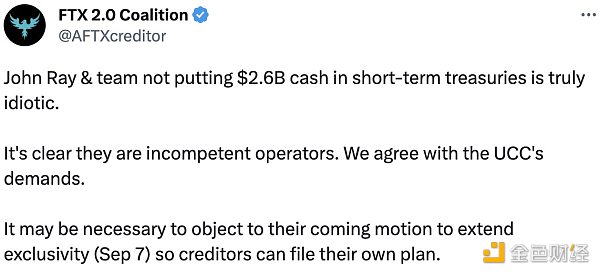New currency war has started: 5 routes compete with 23 countries to build digital currency barriers
Wen Hao Mutual Chain Pulse Yuan Shang
On October 23 (Beijing time), Zuckerberg said at the US hearing that if Libra does not do this, the Chinese central bank will do the digital currency. According to some statistics, when the US Congress discussed Libra, it actually mentioned China 21 times.
On the Chinese side, the research on digital currency has also been accelerated by the Libra white paper. On August 2, 2019, the People's Bank of China stated at the video conference in the second half of 2019 that it would accelerate the pace of research and development of legal digital currency.
The competition between China and the United States on the digital currency has entered the warm-up phase before the start.
- Xi Jinping talks about blockchain, friends circle
- Gavin Wood's "Trust" and "Truth"
- How to deeply understand the new position of the general secretary on the blockchain
More than China and the United States, major economies have launched their own digital currency plans after Libra and the People’s Bank of China have indicated that they will issue DC/EP digital currencies. After all, financial sovereignty in the digital age is not willing to lose.
In fact, it is not only the sovereign countries but also the non-government faction that joins this competition. Its economic theory is Hayek’s monetary theory – the non-stateization of money. The final currency formed is a super-sovereign digital currency.
Five routes to digital legal currency
In the digital age, digital currencies using encryption technology currently have five different routes. The biggest difference is that the issuer is different.
The first route is the unstructured currency distribution represented by bitcoin, in order to achieve super-sovereign currency. After Bitcoin was born, its basic rules did not change significantly, but its maintenance and operation adopted a community model. The community is not a registered institution, and anyone can join or leave. Many supporters believe that Bitcoin has the characteristics of a super-sovereign digital currency.
In the 1940s, Keynes proposed the idea of using 30 representative commodities as the basis for the establishment of the international currency unit "Bancor", but unfortunately failed to implement. Later, people hoped that SDR could be realized, but the role of SDR is obviously not well played. The bureaucratic practice is to maintain the dollar position in the distribution mechanism and scope of use.
Until the emergence of Bitcoin. The chairman of Wanxiang Blockchain believes that gold and bitcoin correspond to super-sovereign currencies.
The second route, when the Bitcoin trading market emerged, lacked the value connection of digital currencies such as French and Bitcoin. In 2014, Bitfinex's Chief Strategy Officer, Philip Potter, and Chief Financial Officer Giancarlo Devasini founded Tether in the British Virgin Islands and issued a stable digital currency USDT with a 1:1 anchor.
The USDT does not have much attempt on monetary sovereignty, nor does it have the ability to exceed sovereignty. The biggest problem is the lack of credit. It is based on the credit of a private company, and the company is still a startup, because its 1:1 "lie" was exposed this year, and the company admitted that only 74% of cash and equivalent support. Even if it comes to hope to develop into a sovereign currency or a super-sovereign currency, the challenge will be greater than Libra.
The third route is Libra. Libra supported the currency credit through an alliance of 28 early non-banking companies. The creditworthiness of these 28 famous companies has indeed surpassed many countries. At the Libra Council in mid-October, although six founding members were retired, Libra also disclosed that more than 1,500 entities hope to work with Libra. Assume that Libra is successfully issued and attracts more and more entities to join, and its credits continue to accumulate. Will Libra leave the legal currency anchoring and issue credit currency to realize super-sovereign currency?
In the recent US Congress’s torture of Facebook, Zuckerberg expressed like a little lamb, saying that this will never happen. He said that the most proportion of the Libra reserve is the US dollar. The most important item of this project. One thing is to be able to expand the financial leadership of the United States. He even said that he was willing to give up a basket of currency combinations, specifically anchoring separate legal currency.
From Libra's current external ambitions, Libra is more like a cross-sovereign currency.
Libra tries to maintain the hegemony of the dollar, but abandoning commercial banks is essentially a matter of doing commercial banking. And commercial banks are not idle, they have opened up the fourth route – jointly invested in the company Fnality.
Fnality received $63.2 million in new funding from 14 banks on June 13 (including UBS, Barclays Bank, Credit Suisse Group, NASDAQ, Deutsche Bank, ING Group, Union Bank of Belgium, Lloyd The Bank of China Group, the Imperial Bank of Canada and the Mitsubishi UFJ Financial Group, among others, joined the banks that joined later, and now have 15 bank shareholders. It plans to mark the five major types of legal currency. The digital legal currency will be held entirely by the central bank. Some cash is used as a collateral to address the “cash on the account” problem faced by other blockchain financial projects. In the early days, Fnaliy only made a large-scale digital legal currency system, realized inter-bank payment transactions, and did not use personal systems. This is actually the business of a wholesale bank.
Fnality does not expect to become a super-sovereign currency. The company mainly provides technical support to realize the issuance of digital currency in sovereign countries. But they all have uniform technical standards, so trading in different currencies is very simple. Their digital token is USC (Utility settlement coin). It is reported that the current core partners are the United Kingdom, the United States, Canada, Japan, and the European Union. It may also add a major currency country in Europe and a big country in Africa. Its currency form is USC-USD, USC-EUR and so on. Currently, Fnality has not hit the wall like Libra, it has safeguarded the interests of the old world.
Many central banks represented by China are more inclined to issue digital legal currency. The digital currency issued by the People's Bank of China is called DCEP (Digital Currency Electronic Payment). Because it focuses on the payment of M0, EP is the meaning of electronic payment. The routes of other countries are not yet clear. But the common denominator is that the issuer is still the national central bank, so it is called CBDC (Central Bank Digital Currency), which is the fifth route.
The fifth route is acceptable to most countries. It will not immediately impact the existing financial system, and at the same time strengthen supervision and better control of monetary policy.

Countries are busy building walls
Libra and China's DCEP have also stimulated the development of digital currencies in global sovereign countries.
In the United States where the Fed is a private enterprise, Libra and JP Morgan and IBM coins were originally considered to be an extension of the hegemony of the dollar in the digital age. However, after Libra suffered a strong opposition, the news came again in October that the Federal Reserve’s FedCoin was re-launched. According to a report by Politico, Libra, the digital currency proposed by Facebook, seems to have forced the Federal Reserve (FED) to reconsider the idea of issuing its own pure digital payment method.
In the past two months, there are still many countries that want to “issue money”.
On October 19th, the Bank of England’s deputy governor said that the Bank of England is very concerned about what measures should be taken to provide public infrastructure to encourage private innovation. Developing a digital currency with other central banks is worth considering because of the big cost and efficiency of cross-border payments.
In early October 2019, the German Finance Minister said when talking about Facebook's Libra, one of the core national sovereignty is issuing currency, and we will not leave it to private companies. In the face of the Internet giant's plan (Facebook issued Libra), it said it will introduce a central bank digital currency called "e-euro", which believes that such a payment system for European financial centers and their integration with the world financial system are Beneficially, this area should not be left to China, Russia, the United States or any private institution.
On September 17, 2019, the European Central Bank Management Committee Villeluva said: The French central bank has begun to study the central bank's digital currency.
On October 15, 2019, according to an internal speech prepared by Bank of Canada Governor Stephen Poloz and the bank's board of directors, the Bank of Canada is considering launching a digital currency to help it defend against the "direct threat" of cryptocurrency.
On October 23, 2019, Venezuelan President Maduro said that the Petro-to-Fiat deal has been authorized and that the Venezuelan government will provide the necessary technology to all business owners who wish to begin accepting cryptocurrency payments.
On September 11, 2019, the Deputy Governor of the Saudi Arabian Currency Board (SAMA) responsible for banking said that Saudi Arabia and the United Arab Emirates will complete the pilot work of cross-border banking transactions in digital currency by the end of the year.
……
Mutual chain pulse statistics, the world's major economies, in addition to Japan and Russia, are already considering or promoting the development of official digital currency.
According to the World Economic Forum (WEF) report, at least 40 central banks around the world are currently working on projects and work on blockchain and distributed ledger technology (DLT). Among them, the most common one is the digital currency issued by the central bank (hereinafter referred to as CBDC).
Inter-Chain Pulse According to publicly disclosed data, 23 countries are working on the development of the central bank's digital currency. Among them, Venezuela, Saudi Arabia, Senegal, Tunisia and Ecuador launched their own digital currency. But most of them have not been popular. Venezuela’s oil coins were approved without anchoring oil or simply not being honored.
In the final analysis, the currency form is only a form of expression. The credit behind the currency can support its circulation and use. Its responsibility also needs to be undertaken by large economies.
The major economies (G20) have not yet issued a digital currency in one country. From the perspective of external progress, the DCEP of the People's Bank of China is in a leading position.

The prevailing view in the industry is that in the future, there will be a situation in which several sovereign countries have coexisting digital currencies. Super-sovereign currencies are hard to become mainstream in the short term. The technical characteristics of Bitcoin determine that it cannot be used for daily payments.
Now, it is not difficult to smell the taste of the new currency war.
This article is [inter-chain pulse] original, the original link: https://www.blockob.com/posts/info/26527 , please indicate the source!
We will continue to update Blocking; if you have any questions or suggestions, please contact us!
Was this article helpful?
93 out of 132 found this helpful
Related articles
- What is the relationship between halving bitcoin and the bull market?
- The first batch of six major activities of the Wuzhen Conference was released!
- Why give up big exchanges and invest in small exchanges? Game Da Yao Guo Haibin summed up the five future investment tracks of the blockchain
- Xi Jinping: Taking the blockchain as an important breakthrough for independent innovation of core technologies
- Borrow money to the DeFi agreement? Good returns, but first assess the risk
- 7 years to receive a $2 billion fee, Coinbase claims to be a unicorn unicorn
- The digital currency exchange has been caught in the throat by the legal currency.





